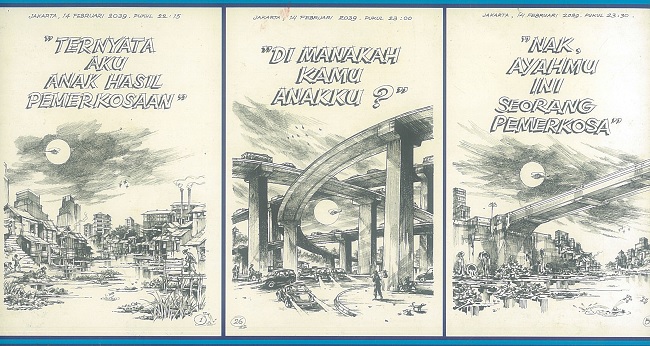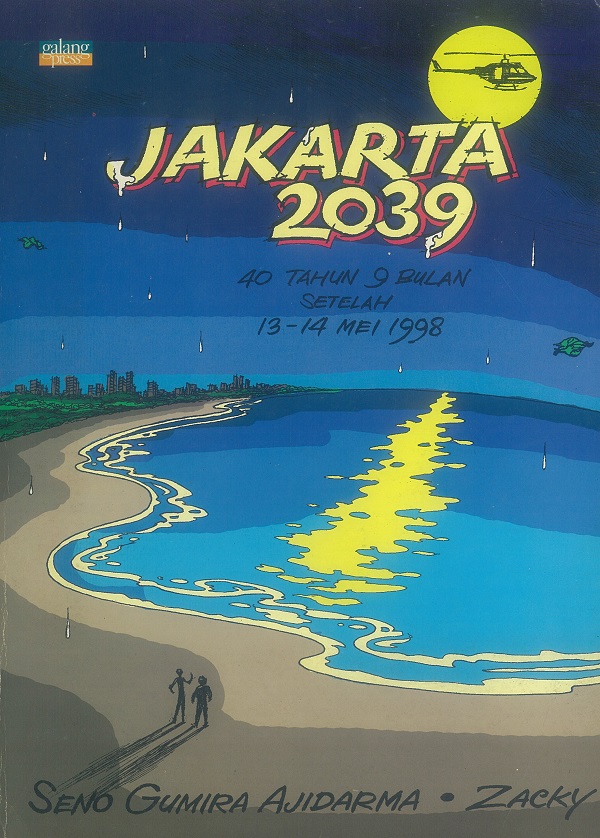Andy Fuller
By the end of the New Order in 1998, the writer Seno Gumira Ajidarma was established as a chronicler of state-based violence and urban society. His collection of stories, Saksi Mata (Eye Witness), published in 1994, was the first literary documentation of the killing and trauma inflicted on the people of Timor Loro Sae, and was partly facilitated by Seno’s journalistic connections. Seno drew on his ability to write tightly framed stories for mass media. He became one of the most prominent writers working within the literary genre known as ‘sastra koran’ (newspaper literature).
After the May 1998 riots Seno wrote three short stories about the violence and gang rapes of mostly ethnic Chinese women that took place in the midst of the rioting in Jakarta and other cities. The stories published in newspapers and magazines at the time were: ‘Clara Atawa Perempuan yang Diperkosa’ (‘Clara or the Woman who was Raped’, published in Republika on 26 July 1998); ‘Jakarta, Suatu Ketika’ (‘Jakarta at a Certain Point in Time’, Horison, June 1999); and ‘Jakarta 2039: 40 Tahun 9 Bulan Setelah 13-14 Mei 1998’ (‘Jakarta 2039: 40 years 9 months after 13-14 May 1998’, first published in Matra, 1999).
‘Jakarta, Suatu Ketika’ is a fragmentary account of the May riots told from the perspectives of a photographer and a young girl who watches on as her house is looted by her neighbours. 'Jakarta 2039', the focus of this essay, is a narrative of the events of May 1998 and like Clara it tells the story of a victim of rape.
In the aftermath of the May riots, in the face of evidence presented by human rights activists working with victims of the riots, figures from government, religious groups and the military denied that rapes had taken place. Seno believed it was important to tell these stories and remember the events of May 1998. Seno’s literary framing had often involved an interplay between the narrator and reader. In this story the malevolent narrator – who determines the ultimate ‘truth’ of the story – has a clear characterisation: that of a policeman who distorts and rejects the narrative of a victim. In the comic version of Jakarta 2039, the story is described as ‘based on a true event, told so that it will not happen again’.
‘Jakarta 2039’
In Jakarta 2039 the events of May 1998 are told from three perspectives: that of the rape victim, that of the rapist and that of the child who was born as a result of the rape. This story was originally published in Matra in December 1999 and was re-published as a comic with illustrations by Yogyakarta based artist Asnar Zacky in 2000. Seno wanted to make the story as widely available as possible, and to reach an audience who might otherwise not read his short stories.
Jakarta 2039 is a three-part collection of inter-twining narratives that start from a simultaneous remembering and questioning of events 40 years before. The three narrators of Jakarta 2039 state in turn: ‘It turns out, I’m the child born from a rape’, ‘Where are you my child?’ and ‘Child, your father is a rapist’ (see image below). The written text appears in speech bubbles against the backdrop of Jakarta’s cityscape.

The first narration is by the woman born as a result of a rape. It is her fortieth birthday. From an apartment block in Jakarta, she narrates her story to a video camera. She explains how she has traced her origins. She is informed by an old woman that she was born as a result of a gang rape that occurred sometime during 13 and 14 May, 1998. The text appears over a drawing of the streets of Glodok, in North Jakarta: smoke rises from buildings, men destroy whatever they can find. She feels, on this, her birthday, as though she has been re-born with a ‘curse’.
The second narrative is that of the mother – the victim of gang rape in May 1998. She narrates her story to her personal computer. She tells how she has tried to forget the rape: ‘memory’ for her is a kind of curse. ‘Why do human beings have a memory? … I haven’t been able to forget that I have been raped like that, oppressed, insulted, abused’. She remembers the faces of the men who raped her. To escape the memory of her rape, she travels through mountain ranges, goes diving and sailing. She goes ‘far overseas’.
She travels to places that are part of the natural landscape: mountains, deserts and the sea. Her ‘escape’ and efforts at forgetting involve a move away from the urban environment and particularly from Jakarta itself. This narration is concluded when the woman turns off her computer. She looks off vaguely into the distance and ‘outside the window, a siren is heard softly – it is a sound of danger’. The narratives of the child and her mother are mediated through the technologies of a video camera and personal computer. The author has also given the urban context particular values of ‘danger’ and ‘anonymity’.
The third narrative of Jakarta 2039 is that of a rapist. On his ‘death-bed’ the man tells his story to his daughter. The man worked as a heavy labourer. Zacky’s drawings show scenes of Sunda Kelapa harbour and of buildings being constructed – both central to the image of Jakarta as leading the way in pembangunan (development). The father closes his eyes and narrates the events of 13 to 14 May, 1998.
He describes the sense of organisation amidst the chaos of the riots: ‘They were carrying jerry cans filled with petrol, pouring it out and lighting flammable goods. There was a panic. Some people were giving orders.’ And a rape scene: ‘A woman was screaming. In between the ruins which were still smoking, a group of men surrounded two women, like wolves surrounding a corpse.’ Then, the narrator recounts to his daughter how he himself raped a woman he came across by chance. He left the scene without looking back. The rapist is not accountable for his actions. The city is in a state of crisis. His actions go unnoticed and he is effectively anonymous.
The third narrator describes how within the state of disorder the riots were simultaneously organised. Instead of being spontaneous outbursts of anger from the urban poor, unnamed figures instructed the crowds. However, the rape committed by the third narrator, is a consequence of his own desires and impulses. His narration concludes with his death.
In Jakarta 2039, the city itself is also a character, which enhances the memory of the events of 1998. Indeed, the victim of the rape must remove herself entirely from urban life. Trauma for each of them is ongoing. Jakarta shifts from being a symbol of Indonesia’s success and development as a nation, to being symbolic of unresolved tensions which fail to be accommodated neatly in the nation.
Jakarta 2039 points to the haunting legacy of unresolved national trauma and state-based violence. The denial of the authenticity of the rapes in May 1998 relates to similar denials of the narratives of victims of the 1965-66 anti-communist violence. Seno Gumira Ajidarma’s oeuvre is not limited to writings on violence, yet, his works frequently show the ability of literature to counter a hegemonic narrative, which seeks to silence alternatives.
Andy Fuller (acsfuller@gmail.com) is an honorary fellow at the Asia Institute, The University of Melbourne. He has translated numerous works of Indonesian literature.
Related Articles from the II Archive
Politics of the Indonesian city
The tragedy of May 1998
Remembering May 1998
